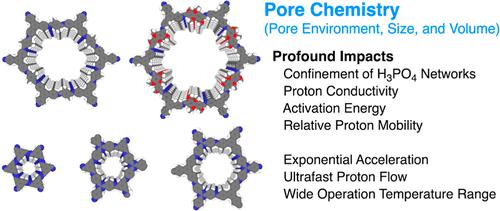当前位置:
X-MOL 学术
›
J. Am. Chem. Soc.
›
论文详情
Our official English website, www.x-mol.net, welcomes your feedback! (Note: you will need to create a separate account there.)
Exceptional Anhydrous Proton Conduction in Covalent Organic Frameworks
Journal of the American Chemical Society ( IF 14.4 ) Pub Date : 2024-06-22 , DOI: 10.1021/jacs.4c06049 Shanshan Tao 1 , Donglin Jiang 1
Journal of the American Chemical Society ( IF 14.4 ) Pub Date : 2024-06-22 , DOI: 10.1021/jacs.4c06049 Shanshan Tao 1 , Donglin Jiang 1
Affiliation

|
Covalent organic frameworks (COFs) offer an irreplaceable platform for mass transport, as they provide aligned one-dimensional channels as pathways. Especially, proton conduction is of great scientific interest and technological importance. However, unlike proton conduction under humidity, anhydrous proton conduction remains a challenge, as it requires robust materials and proceeds under harsh conditions. Here, we report exceptional anhydrous proton conduction in stable crystalline porous COFs by integrating neat phosphoric acid into the channels to form extended hydrogen-bonding networks. The phosphoric acid networks in the pores are stabilized by hierarchical multipoint and multichain hydrogen-bonding interactions with the 3D channel walls. We synthesized five hexagonal COFs that possess different pore sizes, which are gradually tuned from micropores to mesopores. Remarkably, mesoporous COFs with a high pore volume exhibit an exceptional anhydrous proton conductivity of 0.31 S cm–1, which marks the highest conductivity among all examples reported for COFs. We observed that the proton conductivity is dependent on the pore volume, pore size, and content of phosphoric acid. Increasing the pore volume improves the proton conductivity in an exponential fashion. Remarkably, changing the pore volume from 0.41 to 1.60 cm3 g–1 increases the proton conductivity by 1150-fold. Interestingly, as the pore size increases, the activation energy barrier of proton conduction decreases in linear mode. The mesopores enable fast proton hopping across the channels, while the micropores follow sluggish vehicle conduction. Experiments on tuning phosphoric acid loading contents revealed that a well-developed hydrogen-bonding phosphoric acid network in the pores is critical for proton conduction.
中文翻译:

共价有机框架中出色的无水质子传导
共价有机框架(COF)为质量运输提供了一个不可替代的平台,因为它们提供了对齐的一维通道作为路径。特别是,质子传导具有重大的科学意义和技术重要性。然而,与湿度下的质子传导不同,无水质子传导仍然是一个挑战,因为它需要坚固的材料并在恶劣的条件下进行。在这里,我们通过将纯磷酸整合到通道中形成扩展的氢键网络,报告了稳定的结晶多孔 COF 中出色的无水质子传导。孔中的磷酸网络通过与 3D 通道壁的分层多点和多链氢键相互作用而稳定。我们合成了五种具有不同孔径的六角形COF,这些孔径逐渐从微孔调整到介孔。值得注意的是,具有高孔体积的介孔COF表现出优异的无水质子电导率,达到0.31 S cm –1 ,这标志着所有报道的COF实例中电导率最高。我们观察到质子电导率取决于孔体积、孔径和磷酸含量。增加孔体积以指数方式提高质子传导率。值得注意的是,将孔体积从 0.41 更改为 1.60 cm 3 g –1可使质子电导率增加 1150 倍。有趣的是,随着孔径的增加,质子传导的活化能垒以线性模式降低。介孔能够使质子快速跨越通道,而微孔则跟随缓慢的载体传导。 调节磷酸负载量的实验表明,孔隙中发育良好的氢键磷酸网络对于质子传导至关重要。
更新日期:2024-06-22
中文翻译:

共价有机框架中出色的无水质子传导
共价有机框架(COF)为质量运输提供了一个不可替代的平台,因为它们提供了对齐的一维通道作为路径。特别是,质子传导具有重大的科学意义和技术重要性。然而,与湿度下的质子传导不同,无水质子传导仍然是一个挑战,因为它需要坚固的材料并在恶劣的条件下进行。在这里,我们通过将纯磷酸整合到通道中形成扩展的氢键网络,报告了稳定的结晶多孔 COF 中出色的无水质子传导。孔中的磷酸网络通过与 3D 通道壁的分层多点和多链氢键相互作用而稳定。我们合成了五种具有不同孔径的六角形COF,这些孔径逐渐从微孔调整到介孔。值得注意的是,具有高孔体积的介孔COF表现出优异的无水质子电导率,达到0.31 S cm –1 ,这标志着所有报道的COF实例中电导率最高。我们观察到质子电导率取决于孔体积、孔径和磷酸含量。增加孔体积以指数方式提高质子传导率。值得注意的是,将孔体积从 0.41 更改为 1.60 cm 3 g –1可使质子电导率增加 1150 倍。有趣的是,随着孔径的增加,质子传导的活化能垒以线性模式降低。介孔能够使质子快速跨越通道,而微孔则跟随缓慢的载体传导。 调节磷酸负载量的实验表明,孔隙中发育良好的氢键磷酸网络对于质子传导至关重要。
















































 京公网安备 11010802027423号
京公网安备 11010802027423号